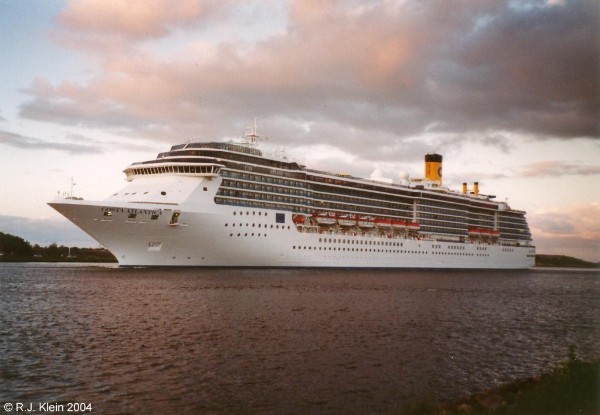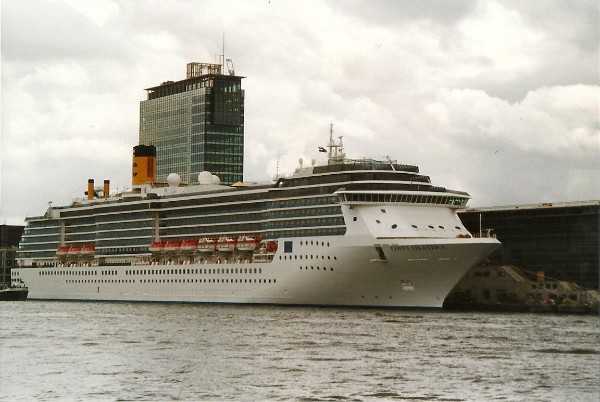Costa Atlantica
In the end of the 1990's, Carnival started introducing multiple-brand ship designs. The Carnival Corporation had grown to mythical proportions and in order to keep the financial balance straight, it seemed to be cheaper to adjust one overall design to the several brands instead of building ships for every company independently. The basic layout of these ships is exactly the same, but every ship has its own identity and, with the Costa ships, they all feature an Italian atmosphere, in contrast with the American orientated Carnival ships.
The first ship of the new class, dubbed the Spirit-class named after the first of the ships that would be built for Carnival itself, was to be a ship for Costa the Costa Atlantica. Costa was Carnivals biggest stronghold in Europe. After her, three ships would follow for Carnival, the Carnival Spirit and the Carnival Pride in 2001 and the Carnival Legend in 2002. In 2003, a second ship in the class was introduced for Costa, named Costa Mediterranea and the last ship was the Carnival Miracle introduced in 2004. The ships were built at the Kvaerner-Masa yards in Helsinki, Finland. The yardnumber for the first of the sisters, Costa Atlantica, was 498.

Costa Atlantica sailing the Northsea Canal near Buitenhuizen in the Netherlands at the 21st of april, 2004.
The ship has a lenght of 292,56 meters, a width of 32,20 meters and a draft of 7,80 meters, still able to transit the Panama canal. Her tonnage is 85.619 and she can sail with up to 2680 passengers in 1057 cabins of which 79% have an ocean view, catered for by 902 crewmembers in 509 cabins. She was the first ship in the Carnival-owned fleet that was driven by two pods instead of screws and her maximum speed provided by her Wärtsilä-designed diesel engines is 24 knots.
The blueprint of the hull of the Spirit-class ships was also the basis for the Vista-class, that was divided between Holland America Line, Cunard Line and P&O Cruises. Again next to this, Costa Luminosa and Costa Deliziosa are also based on the same ideas, being a combination of the Spirit- and Vista-classes. For the builders, the Spirit-class is known as the 8000-class and the Vista-class is known as the 9000-class, just a slight variation. As you can see, the Spirit-class was the first class of ships within the Carnival family that was used for more of the brands in the companies portfolio, hailed by some as the starting point of the end of the own personalities of the Carnival-owned companies. Most large cruiseships built for the Carnival Corporation since 1996 are only part of three big families. Next to the Spirit-class (including the Vista-sisters) and the Grand-class of P&O Princess, there is also the Destiny-class and all its variations. It is a little sad to see those companies losing much of their own identities and this also makes it less interesting because of the lack of new designs for the large companies. On the other hand, it also must be said that those classes also attract many passengers, because they are truly well-designed with many spacious venues and a good flow of passengers throughout. Next to that, there are so many other companies to choose from and so many other ships, so saying that it makes the industry plain and dull is just a little too easy.
Costa Atlantica left her building dock at the 11th of november 1999 and after she was finished, sailed on her official trials between the 15th and 20th of may 2000. At the 30th of june the ship was officially delivered to Costa Crociere and she made her way for Venice, where she was to be named by her Madrina (godmother) Claudia Cardinale, an Italian moviestar who performed in the film '8 1/2' that was directed by Federico Fellini, who also has a close connection to the ship. The cermony was very spectacular, like Costa namings mostly are, with four large colourfull balloons that represented the four winds floating next to the vessel, and acrobats abseiling down the side of the ship. Among the invited guests were of course the builders, designers and owners, but also the Vatican's bishop for tourism. At the time, the ship broke some records. She was the largest Italian-flagged passengership ever, the largest ship built by Kvaerner to date and the largest cruiseship dedicated to the European cruisemarket. Also, she was the first Costa ship designed by the house-designer of Carnival, Joe Farcus. The ship adopted the new cruiseship design of the public rooms on the lowest decks and the cabins on the highest to the full, the 10-deck high atrium was placed more in the center of the ship instead of more forward and this way, more public rooms could be entrered through the atrium. Spectacular is also the glass staircase that spans over the top of the atrium so you can be dazzled by its depth when you like to reach the Club Atlantica restaurant for exclusive dining. Next to this all, it is the first Costa ship that adopted the idea of an overall theme, now widespread through the fleet. The ship was themed after one of Italy's most famous moviedirectors Federico Fellini. All decks were named after movies he made.

Costa Atlantica as seen at the Amsterdam Passenger Terminal at the 21st of april 2004. The ship replaced the smaller Costa Europa that was based in Amsterdam before, but was later replaced herself by the larger Costa Luminosa in 2010. Amsterdam is now one of the major Costa ports in the Norhtern part of Europe.
The ship is called 'Italian Carnival without the neon' by Paul Motter at the cruisemates website and that is totally true. Although the ship is an American design, the interiours are very Italian. There are Milano glass sculptures in the staircases, on the Estrada deck (3) is a true replica of the 18th century founded Caffe Florian, originally located at the Piazza San Marco in Venice. Music that is played at the café on the ship is the same as the music you will hear when you are sitting at the terrace of the original café in Venice. Also, visuals and murals are truly inspired from Italy and the main shopping arcade onboard in named Via della Spiga, after the famous shopping street in Milan. So the ship does have an Italian vibe aboard, although the Costa Atlantica and her later sister Costa Mediterranea also recieved a totally new style for Costa, based on the interiours of the American-orientated Carnival sisters. So there also is the mirror-polished, glittery floors under your feet and the neonsigns before your eyes. When Las Farcus...Vegas...was built in Italy, it would look a little like those ships. In Europe, thoughts about the new Costa ships are mixed. On the one hand, every European wants to feel like an American and listen to American music, drink coffee at Starbucks and like to have everything BIG. On the other hand, we also like our own culture and smallish way of life. Some of the new Costa liners can become a little too Americanized and maybe that is one of the reasons of the spectacular growth of that other Italian company in the last decades, MSC Cruises. Their ships have stylish, tastefull interiour spaces more in line with the European way of life.
Her initiaries were normally European in summer and in winter she sails the Caribbean. Her first cruise started from Venice in the Mediterranean at the 16t of july 2000. From 2013 onwards, the Costa Atlantica was also seen more-often in Asia, as this was truly the new growing market for Costa Cruises. On the 2nd of march 2015, the ship had an industries first, as she departed on the first ever worldcruise from China. The 86-day cruise departed from Shanghai and took her via the Maldives, the Mediterranean, the east- and westcoast of the United States and the Polynesian islands back to Asia. Because of the significance of this voyage, many journalists attended her departure, as well as the CEO of the Costa Group Michael Tamm and several tradepartners of Costa Cruises Asia.

